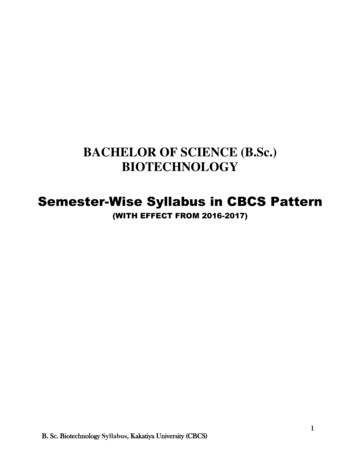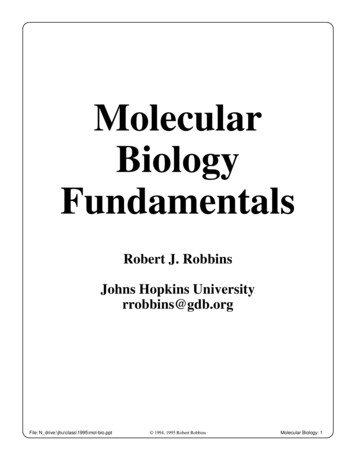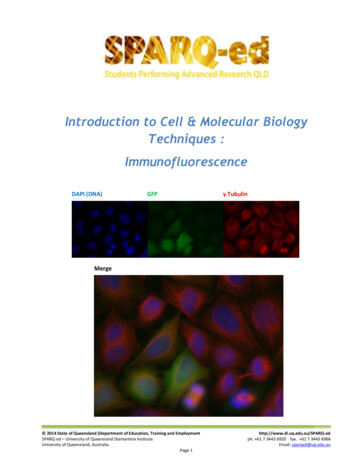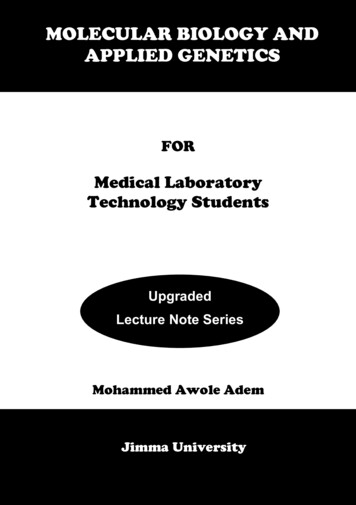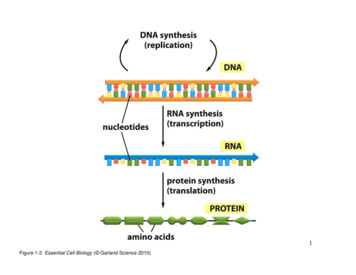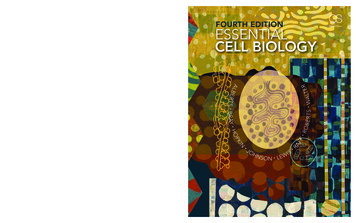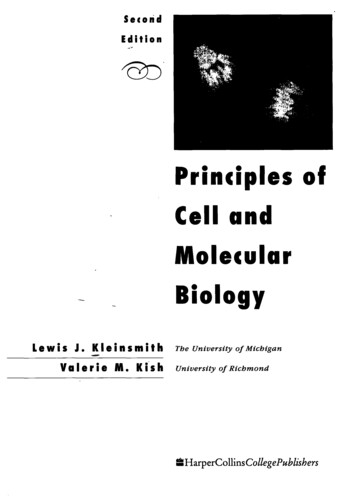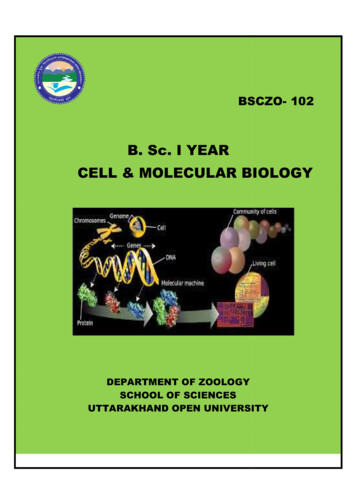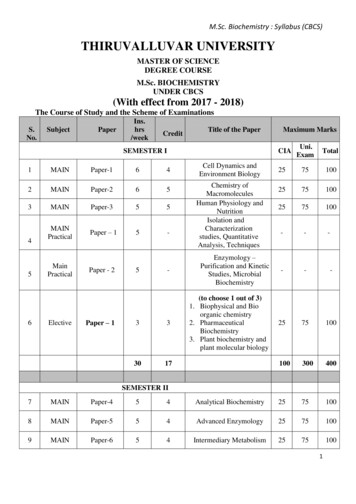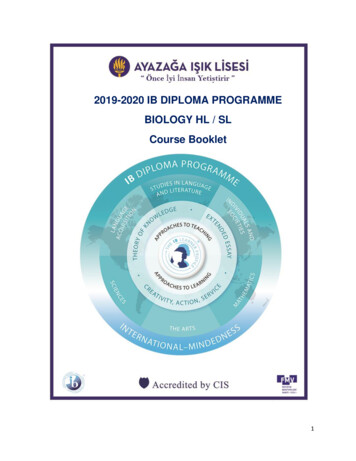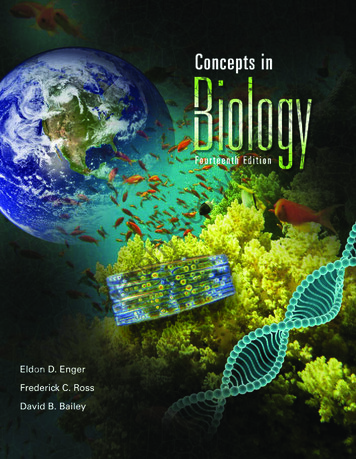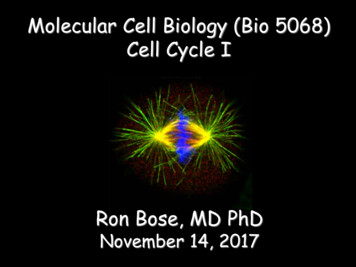
Transcription
Molecular Cell Biology (Bio 5068)Cell Cycle IRon Bose, MD PhDNovember 14, 2017
CELL DIVISION CYCLEMG2SG1
DISCOVERY AND NAMING OF CYCLINSA protein (called “cyclin”) was observed to increase ascells approached mitosis, peak in mitosis and thenprecipitously disappear as cells exited mitosis.
Two proteins (cyclins A and B) increased as cells approachedmitosis, peaked in mitosis and precipitously disappeared ascells exited mitosis.
The cell cycle is primarily regulated bycyclically activated protein kinasesFigure 17-15, 17-16 Molecular Biology of the Cell, 4th Edition
Overview of major cyclins and Cdks ofvertebrates and yeastTable 17-1. Molecular Biology of the Cell, 4th Edition
Evolution of cell cycle control: from yeast to humansMalumbres M, Nature Reviews Cancer 2009
Cdk activity is regulated by inhibitoryphosphorylation and inhibitory proteinsWhy is cell cycle progression governedprimarily by inhibitory regulation?Figure 17-18, 17-19. Molecular Biology of the Cell, 4th Edition
Cell cycle control depends on cyclical proteolysisFigure 17-20. Molecular Biology of the Cell, 4th Edition
UBIQUITIN-MEDIATED PROTEOLYSISDeshaies RJ and Joazeiro CA.Annu Rev Biochem. 2009E1 (Ubiquitin activating enzyme)Binds to Ubiquitin in an ATP-dependent mannerPasses Ubiquitin to E2E2(Ubiquitin conjugating enzyme or UBC)At least 12 in yeastsome are specific to a given targetE3 (ubiquitin protein ligase)Large complexin both clam (cyclosome) and inPROTEOLYISfrog (APCUBIQUITIN-MEDIATED anaphase promoting complex). Final transfer ofubiquitin to substrate can be mediated by E2 alone or E2acting in concert with E3Proteosome (26S complex) Structure from archaebacterium solved.
APC Anaphase P romoting C omplexRequired for degradation of substrates at Metaphase toAnaphase transition ( ie: B-type Cyclins and securin)WD repeatcontainingproteinsHave D orKEN c20 or(E2)ApcxCdh1/Hct1 Ring fingerApc11Apc1/Apc4BimECullin Apc2Apc5Cdc23Apc10Cdc27Apc8Apc3Apc7Cdc16Apc6Cdc20 :targets cyclin A and B-type Cyclins, securinCdh1/Hct1: targets Plk1 and B-type cyclins
SCF Ubiquitin LigasesComponents:F Box: adapterBrings substrate to E3 ligase.F-box binds to Skp1Additional protein interaction domains(PID: WD repeat, leucine-rich repeat) binds to substrateE2:UBIQ. Conjugating enzyme (transfers UB to substrate)Skp1:Bridges F-box to cullinCullin:Organizes and activates E3 complexRecruits E2-UBIQ conjugating enzymeRing finger proteinParticipates in E2 binding and catalysis
SCF E3 Ubiquitin LigasesO'Connell BC, Harper JW. Curr Opin Cell Biol. 2007
CELL CYCLE REGULATION OF Cdc2ReversiblephosphorylationInhibitory T14 Y15 T161P PT161PPCdc2Cdc2Cdc2Cyclin BCyclin BCyclin BINACTIVEINACTIVECdc2Cdc2INACTIVECyclin BActivating Kinase(s)ACTIVEUbiquitinmediatedproteolyisINACTIVE
Cyclin-dependent Kinase Inhibitor Proteins (CKI’s)1. CIP/KIP family (p21Cip1, p27Kip1, p57Kip2):a. Binds to Cdk2 and inhibits activity.b. Binds Cdk4/6 and helps assemble complexes withcyclins.2. INK4 family (p16, p15, p18, p19).a. Specific for Cdk4 and Cdk6.b. Binds Cdk subunit alone and prevents cyclin bindingc. Bind and inhibit Cdk4/6-Cyclin D heterodimers.
G1 ControlMCdk 4 & 6Cyclin D1, 2, 3INK4a proteins(p15,16, 18, 19)G2SAssembly &SequestrationG1Cdk2Cyclin ECip/Kip proteins(p21, p27, p57)
Mechanisms controlling G1/S-phase transitionMITOGENICorHORMONALSIGNALSCYCLIN D Stability andCYCLIN D-dependent Kinases(Cdk4/Cdk6)Rb1E2FTranscriptionfactorFigure 17-30. Molecular Biology of the Cell, 4th Edition
G1 ControlCYCLIN ECDK2MITOGENICSIGNALSCYCLIN D STABILITYCYCLIN D-DEPENDENT KINASES(Cdk4/Cdk6)RBE2FCYCLIN ES-PhaseE2FRelief of Rb- mediatedtranscriptional repressionS-PHASE GENESCYCLIN A &S-PHASE GENESS-Phase
G1 Controlp27KIP1p27KIP1-PhosphorylationUbiq-Mediated proteolysisAssembly &SequestrationCYCLIN ECDK2MITOGENICSIGNALSCYCLIN D STABILITYCYCLIN D-DEPENDENT KINASES(Cdk4/Cdk6)RBE2FCYCLIN ES-PhaseE2FRelief of Rb- mediatedtranscriptional repressionS-PHASE GENESCYCLIN A &S-PHASE GENESS-Phase
CheckpointsWhat are they?How were they defined?How does their derailment contribute tocancer?
CHECKPOINTSIMPROPER SPINDLEASSEMBLYMDNA DAMAGEUNREPLICATED DNAG2STOP!SG1DNA DAMAGE
Checkpoints: intracellular signaling pathways that determine if previous stepsare complete before proceeding onto the next stage (complete DNA synthesisbefore entering mitosis; spindles must be assembled before exiting metaphaseand entering into anaphase) and whether there has been any damage to the DNA.DNA damage checkpoint: integrity of DNADNA damage is repaired before entering S, completing S or entering M.DNA replication checkpoint: replication state of DNAComplete DNA synthesis before mitosis.Spindle assembly checkpoint: integrity of spindlespindles must be assembled before exiting metaphaseinto anaphase.
DNA DAMAGE RESPONSE PATHWAYMG2-PHASE CHECKPOINTG2STOP!SG1G1-PHASE CHECKPOINTS-PHASE CHECKPOINT
CELLULAR RESPONSES TO CHECKPOINT ACTIVATION(IR, etoposide, HU, gemcitibine, irinotecan, carboplatin )CHECKPOINTSG1SG2TEMPORARYCELL CYCLE ARRESTAPOPTOSISM& activation of DNA repair pathwaysSENESCENCE
Fig. 2Chemo- luorouracil scenceApoptosisCHK1p2114-3-3σCDC25ACell Cycle ArrestRAD51FAND2FANCEDNA Repair
DNA DAMAGE CHECKPOINTSIR/VP16replicationstressDNA DSBsssDNAATRATMChk2p53Mdm2 Chk1p21, 14-3-3σCdc25ACyclin B/Cdk1Cyclin E /Cdk2G1DEATHG1-checkpointSG2S-phase checkpointMG2 checkpointOverproduced in certain cancers.Inactivated in certain cancers.
DNA damage leads to cell cycle arrest in G1Figure 17-33. Molecular Biology of the Cell, 4th Edition
Mitogens stimulate cell divisionFigure 17-41. Molecular Biology of the Cell, 4th Edition
Excessive stimulation of mitogenic pathwayscan lead to cell cycle arrest or cell deathFigure 17-42. Molecular Biology of the Cell, 4th Edition
Extracellular Survival Factors Suppress ApoptosisFigure 17-47. Molecular Biology of the Cell, 4th Edition
Cell cycle regulators are frequently disrupted in cancerMalumbres M, Nature Reviews Cancer 2001
Overview of CDK inhibitors in clinicaldevelopment for cancer therapyO’Leary et al., Nature Reviews Clinical Oncology 2016
Turner et al, NEJM 2015
NEJM Nov. 3, 2016
Conclusions1. The cell cycle is a coordinated and tightly organizedprocess to ensure the successful replication of the cell.2. Activity of CDK-Cyclins is determined by:1. Synthesis of Cyclins.2. Reversible phosphorylation/dephosphorylation ofstimulatory and inhibitory sites on CDK.3. Ubiquitin mediated degradation of Cyclins.4. CDK inhibitors – INK4 and CIP/KIP families.3. Checkpoints can halt the cell cycle if all steps have notbeen properly completed.4. Cancers have many alterations in cell cycle proteinsand selective CDK4/6 inhibitors are now used incancer treatment.
Figure 17-15, 17-16 Molecular Biology of the Cell, 4th Edition . Table 17-1. Molecular Biology of the Cell, 4th Edition Overview of major cyclins and Cdks of vertebrates and yeast . Malumbres M, Nature Reviews Cancer 2009 . Evolution of cell cycle control: from yeast to humans .
